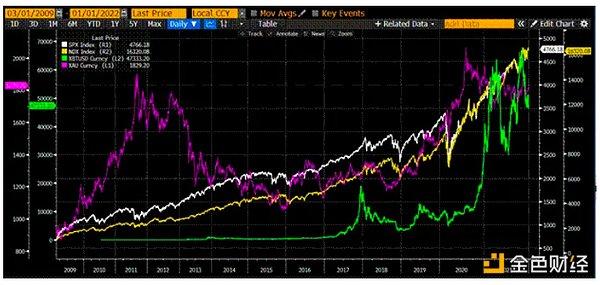User demand is shifting from the "block space" to the "wallet space", and attention will become the most valuable resource in the crypto economy.
Original: The Fat Wallet Thesis (X)
Author: Robbie Petersen, Researcher at Delphi Digital
Translator: Luffy, Foresight News
Cover: Photo by Shubham's Web3 on Unsplash
Throughout the history of cryptocurrencies, the capture of value in the blockchain stack has been a topic of much discussion. The core debate has always been between the protocol layer and the application layer, but there is a third layer in the stack that most people have overlooked: the wallet.
The "Fat Wallet" thesis argues that as protocols and applications become "leaner", those who own the two most valuable resources - distribution and order flow - will capture the most value. And as the ultimate front-end, no one is better positioned to monetize this value than the wallet.
This article will explore the "Fat Wallet" thesis in three steps. First, we will outline three structural trends that will continue to drive the commoditization of the protocol layer and the application layer. Second, we will explore the various ways wallets can be profitable, including payment for order flow (PFOF) and distribution-as-a-service (DaaS). Finally, we will discuss why Jupiter and Infinex may beat wallets in the competition for user attention.
Protocol and Application Slimming
The question of where value will ultimately accrue in the blockchain stack can be simplified into a simple framework. For each corresponding layer of the stack, ask yourself the following:
If products in this layer increased their fees, would users leave and choose cheaper alternatives?
In simple terms, if Arbitrum raised its rates, would users switch to using other protocols like Base, and vice versa? Similarly, in the application layer, if dYdX raised its rates, would users switch to using other undifferentiated perpetual DEXs.
Based on this logic, we can identify where the highest switching costs are, and thus determine who has strong pricing power. Conversely, we can use this framework to identify where switching costs are lowest, and thus determine which layer of the stack will become increasingly commoditized over time.
While historically, protocols have had strong pricing power, I believe this is changing. Today, there are three structural trends that are increasingly "weakening" the protocol layer:
- Multi-chain applications and chain abstraction: As applications deploy across multiple chains to remain competitive, cross-blockchain user experiences will become increasingly indistinguishable, in turn lowering the switching costs between protocols. Furthermore, chain abstraction through cross-chain bridges will further compress switching costs. As a result, applications will no longer be beholden to the network effects of a single chain, and instead, chains will become increasingly beholden to the traffic distribution of applications.
- Maturation of the MEV supply chain: While MEV will never be fully eliminated, there are many initiatives, both at the application layer and closer to the base layer, to redistribute the MEV extracted from users. Importantly, as the MEV supply chain matures, value will accrue increasingly to the MEV supply chain, and then be captured by applications with the most exclusive user order flow. This means protocols will lose bargaining power, while the position of the front-end and wallets will rise.
- Rise of the proxy paradigm: In a world where transactions are primarily executed by proxies and "solvers" rather than humans, attracting this proxy flow will become a necessary condition for blockchain survival. Importantly, given that proxies and "solvers" are programmed to optimize for best execution, protocols will no longer compete on intangible assets like "decentralization". Instead, transaction fees and liquidity will be paramount, which will only further "weaken" the protocol layer as protocols are forced to compress fees and incentivize liquidity to remain competitive.
So, revisiting our initial question: if a protocol raised its fees, would users leave it for cheaper alternatives? While this may not be obvious today, I believe that as switching costs continue to compress, the answer for an increasing number of protocols will be: YES.
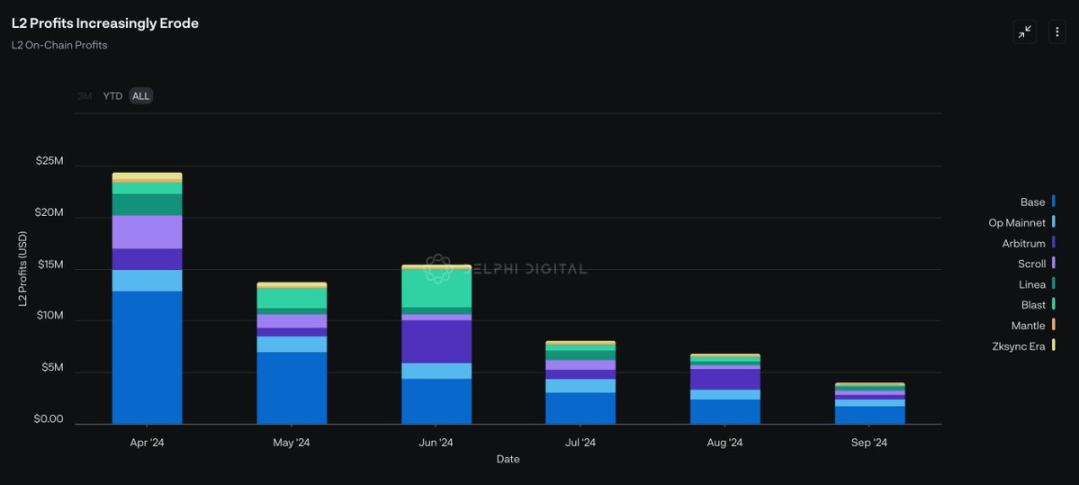
Intuitively, one might think that if protocols are weakened, applications must necessarily become stronger. While applications will certainly recapture some of the value, the "Fat Application" thesis itself is an oversimplification. The way value accrues to different vertical applications varies, and the question is not "will applications get fatter?", but "which applications?".
As I mentioned in "A New Framework for Crypto Market Moats", the unique structural differences of crypto applications (forkability, composability, and token-based value capture) can lower the entry barriers and costs for emerging competitors. Therefore, while a few applications may have some attributes that are not easily replicated, as crypto applications, cultivating moats and maintaining market share is extremely difficult.
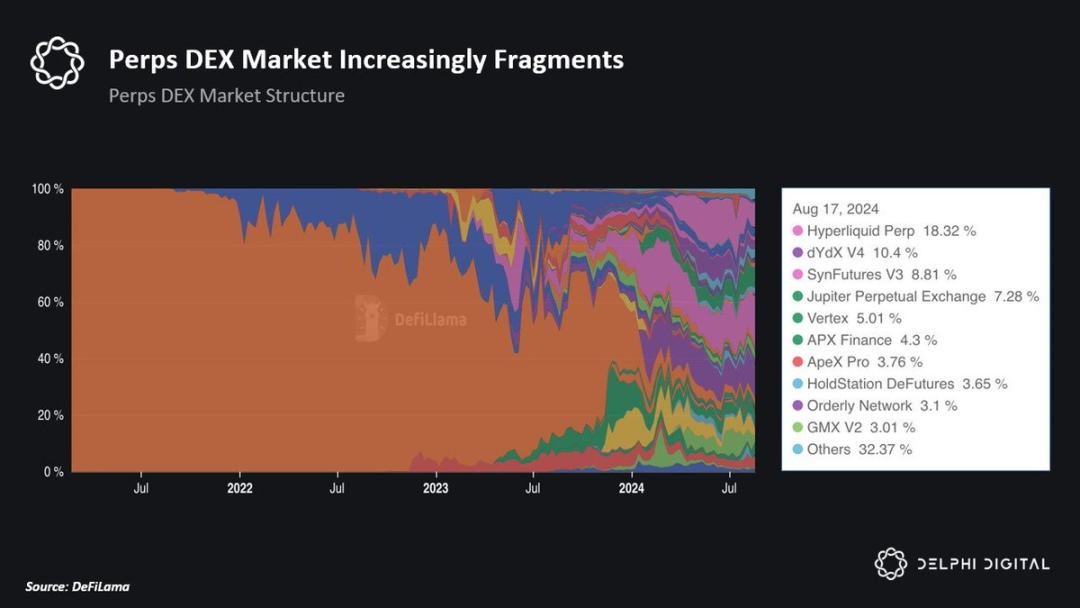
Let's return to our original framework: if an application increases its fees, will users choose a cheaper alternative? I believe 99% of applications will face this problem. Therefore, I expect most applications will struggle to capture value, as turning on the paywall will inevitably lead users to the next undifferentiated application offering more generous incentives.
Finally, I believe the rise of AI agents and solvers will have a similar impact on applications as it does on protocols. Given that agents and "solvers" are primarily optimizing for execution quality, I expect applications will also be forced to compete fiercely to attract agent flow. While network effects should eventually lead to a winner-take-all dynamic in the long run, in the short and medium term, I anticipate applications will experience a race to the bottom.
This raises the question - if both protocols and applications are continuously eroding, where will value re-aggregate?
"Fat Wallet" Theory
The simplest answer is: whoever owns the end-user, wins. While in theory this could be any frontend including applications, the "fat wallet" theory posits that no one is closer to the user than the wallet.
Wallets dominate the mobile crypto user experience: To understand who owns the end-user in the mobile web, the best litmus test is to ask: which Web2 application does the user ultimately interact with? While most users "interact" with the Uniswap frontend to trade, they still access this frontend through a wallet application. This means that if mobile devices dominate the crypto user experience, wallets will only continue to strengthen their connection to the end-user.
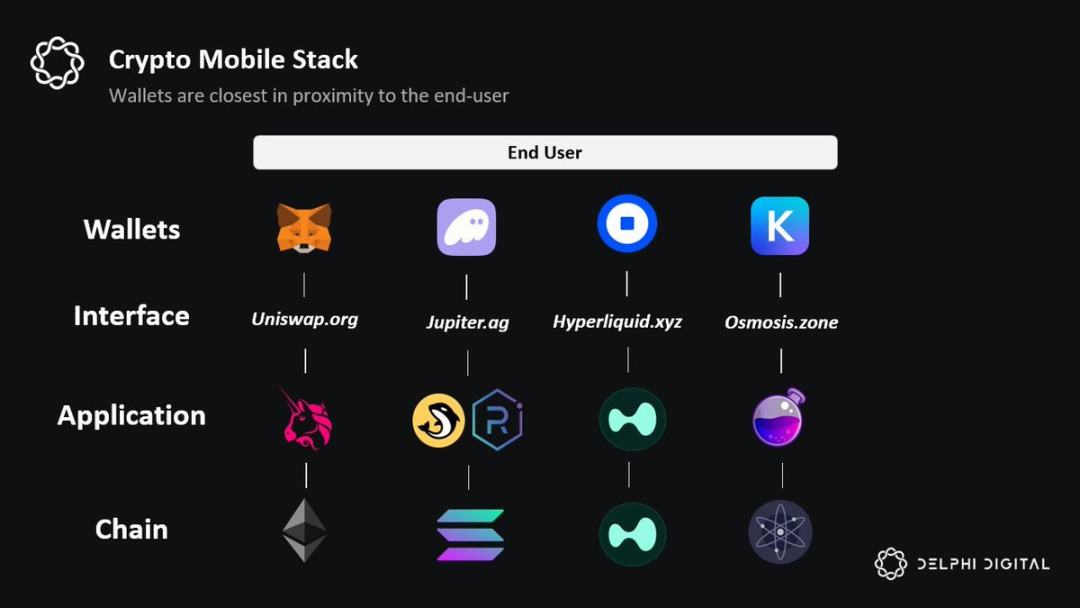
Wallets are where the users are: Crypto applications are fundamentally financial. Unlike Web2, nearly every on-chain transaction is some form of financial transaction. As such, the account layer is critical for crypto users. Additionally, there are unique wallet-layer functionalities: payments, native yields on idle user deposits, automated portfolio management, and other consumer use cases like crypto debit cards.
Wallet switching costs are remarkably high: While in theory, switching wallets is as simple as copying and pasting a seed phrase, for most ordinary users, this is still a psychological hurdle. Given the high level of trust users have in wallet providers, I believe brand and "affinity" are powerful moats at the wallet layer. Revisiting our original question: if wallets increase their fees, will users switch to cheaper alternatives? The answer seems to be: "NO". The MetaMask wallet's swap function charges a 0.875% fee, yet it still has a large user base.
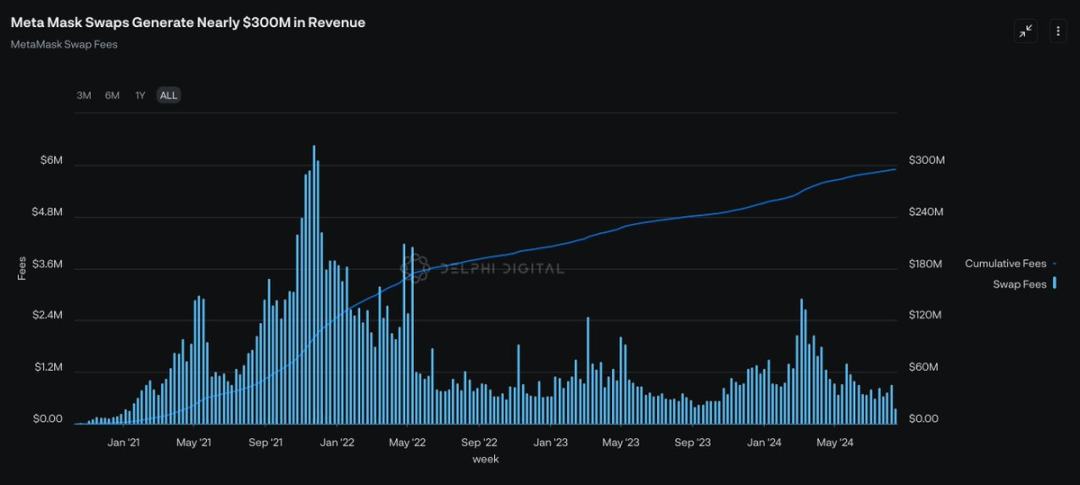
Chain abstraction: While chain abstraction is a technically thorny problem, one of the more compelling solutions is to solve the chain abstraction problem at the wallet layer. The idea of being able to easily access any on-chain application through a single account balance seems particularly intuitive. Projects like oneBalance, Brahma, Polaris, Particle Network, Ctrl Wallet, and Coinbase's smart wallet are all moving towards this vision. In the future, I expect more teams to meet user needs through wallet-layer chain abstraction.
Unique synergies with AI: While I expect AI agents to increasingly commoditize the rest of the blockchain stack, users will still need to authorize agents to ultimately execute transactions on their behalf. This means the wallet layer is best positioned to be the canonical frontend for AI agents. Integrating AI's capabilities at the account layer could include automated staking, yield farming strategies, and more.
We've outlined the "why" of wallets owning the end-user relationship, so let's now consider how they might "monetize" this relationship.
Monetization Opportunities
The first monetization opportunity for wallets is owning the user order flow. As I mentioned earlier, while the MEV supply chain will continue to evolve, one thing will become inevitable: value will disproportionately accrue to those with exclusive access to order flow.
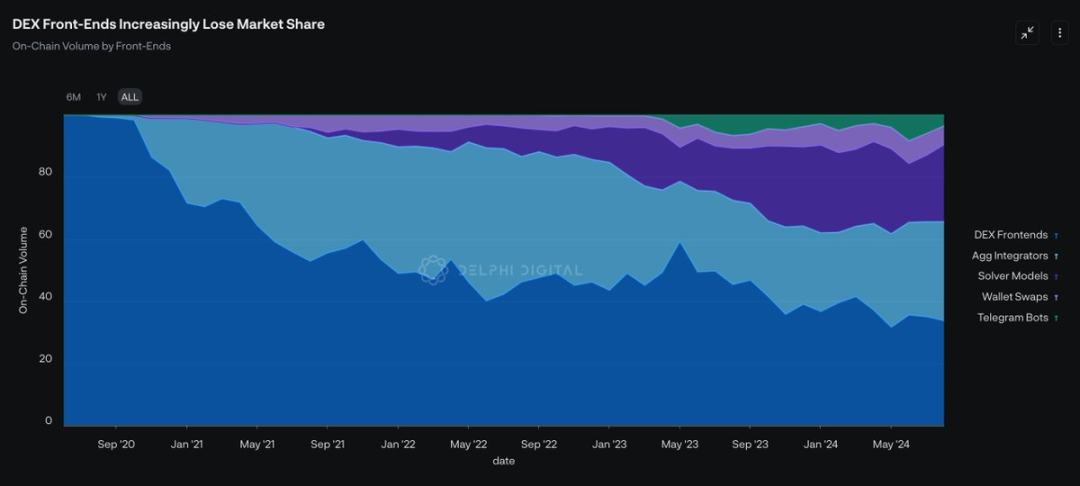
Today, the frontends that own the majority of order flow by volume are solvers and DEXes. However, this chart doesn't reveal the nuances. The key is to understand that not all order flow is created equal. There are two types of order flow: (1) fee-sensitive order flow and (2) fee-insensitive order flow.
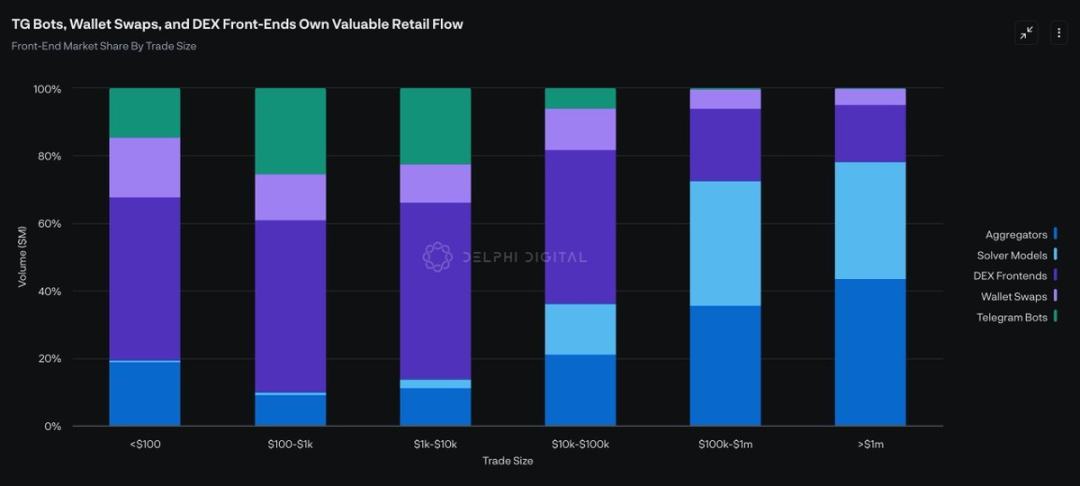
Generally, solvers and aggregators dominate the "fee-sensitive" order flow. Given these users' trade sizes typically exceed $100k, execution is critical to them. These traders won't accept even a 10 bps premium. As such, "fee-sensitive" traders are a lower-value customer segment. While they account for the majority of frontend market share by volume, they generate far less value per $1 of trade.
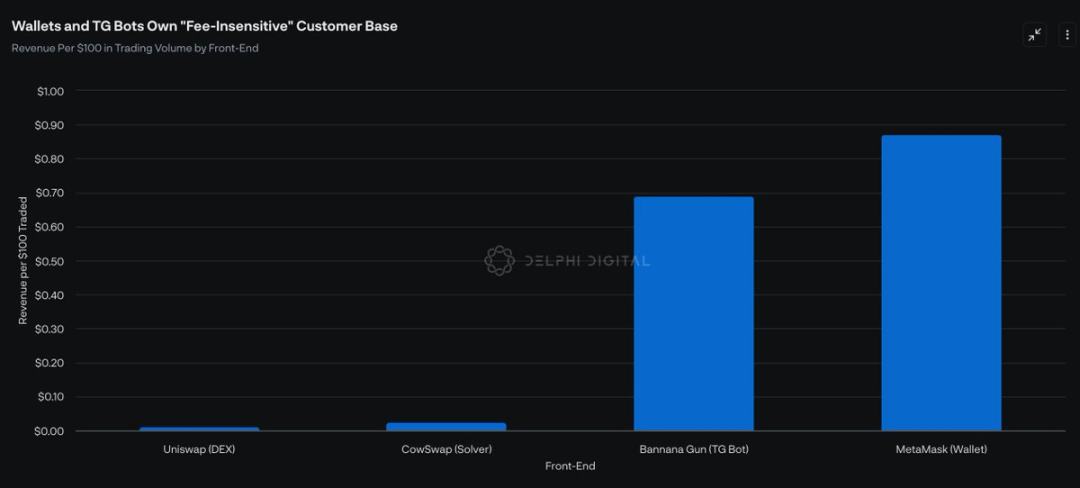
In contrast, wallet swaps and TG bots own a more valuable user base: "fee-insensitive" traders. These traders aren't paying for execution, they're paying for convenience. As such, paying 50 bps for a trade is irrelevant to these users. Therefore, TG bots and wallet swaps generate significantly more revenue per $1 of trade volume.
Looking ahead, if wallets can leverage these trends and continue to own the end-user relationship, I expect the swap functionality within wallets to continue cannibalizing market share from other frontends. More importantly, even a 5% market share gain could have a massive impact, as wallet swaps generate nearly 100x the revenue per $100 of trade compared to DEX frontends.
The second monetization opportunity for wallets, by virtue of being closest to the end-user, is Distribution-as-a-Service (DaaS).
Beyond serving as the canonical frontend for users' on-chain interactions, applications will ultimately still depend on wallets as distribution channels, especially in the mobile web. Thus, similar to how Apple monetizes through iOS, wallets could strike exclusive deals with applications in exchange for distribution services. For example, wallet providers could build their own app stores and charge applications through some revenue-sharing arrangement.
Likewise, wallet providers could also steer users towards using specific applications in exchange for some economic sharing. This approach has an advantage over traditional advertising in that users can seamlessly purchase and interact with the application directly from their wallet. Coinbase appears to be exploring a similar path, with its "Featured" apps and in-wallet "Missions".

Wallets could also earn economic returns by sponsoring user transactions to promote the adoption of emerging blockchains. For example, perhaps Bearachain just wants users to join their blockchain. They could pay MetaMask a fee to sponsor Bearachain's cross-chain fees and gas costs. Given wallets ultimately own the end-user, they can negotiate favorable terms.
As more users access the on-chain world primarily through wallets, we can see demand shifting from "block space" to "wallet space", as attention becomes the most valuable resource in the crypto economy.
Challenges Facing Fat Wallets
Finally, while wallets have a clear lead in the race for end-user ownership, I remain excited about the prospects of two alternative frontends:
- Jupiter: Through their DEX aggregator, Jupiter has been able to cultivate strong relationships with end-users. This can be seen as the best starting point for them to build other related products in the crypto space, including their perps DEX, Launchpad, native LST, and their recent RFQ/Solver product. I'm particularly excited about the launch of the Jupiter mobile app, as it can allow them to get in front of end-users in the mobile environment before wallets.
- Infinex: By acting as a front-end aggregator for applications on EVM chains and Solana, Infinex aims to provide a CEX-like experience while retaining non-custodial and permissionless principles. Infinex will initially offer spot trading and staking services, and plans to integrate perpetual contracts, options, lending, margin trading, yield farming, and fiat on-ramps. By abstracting the account layer and using Web2-familiar features (such as keys), I believe Infinex has the potential to replace wallets as the de facto crypto front-end.
While I'm not yet clear on who will ultimately win the battle for end-user attention, it's becoming increasingly evident that (1) user attention and (2) exclusive order flow will continue to be the scarcest, and therefore most monetizable, resources in the crypto economy. Whether it's wallets or alternative front-ends like Infinex or Jupiter, I expect the value capture kings in crypto will be the projects that own these two resources.
Disclaimer: As a blockchain information platform, the articles published on this site represent the views of the authors and guests only, and are not related to the position of Web3Caff. The information in the articles is for reference only and does not constitute any investment advice or offer, and please comply with the relevant laws and regulations of your country or region.
Welcome to join the official Web3Caff community: X(Twitter) account | WeChat reader group | WeChat public account | Telegram subscription group | Telegram discussion group







